Holste Says: |
 |
| The introduction of lean manufacturing methods into the DC environment forces planners to adopt a more pull verses push approach to system design. |
|
What Do You Say?
|
|
|
|
Previous Columns by
Cliff Holste |
|
|
DC automation comes at a time when the logistics industry, especially in the USA, is struggling to keep up with the ever changing demands of the global e-commerce marketplace. While next day shipping is being offered by most consumer goods companies, same day shipping is the goal of a few trend setters. It appears that the path leading to success and better margins clearly involves the adoption of automation coupled with lean manufacturing methods.
A visit to ProMat 2015 & Automate 2015 will reveal a whole new world of DC automation technologies. Most of this technology is in reality not new. Shippers throughout Europe and Japan, driven by increasingly high labor cost and limited building space, have been automating their DCs for several decades.
Domestic shippers looking to significantly improve DC operations through the adoption of advanced material handling technologies have somewhat different challenges than their European counterparts and therefore should begin by first reassessing their business models and execution systems, and leverage these assessments to find cost reductions and customer service improvements.
They can get the ball rolling by seeking answers to (3) strategic questions:
1. How can we become more efficient, leaner and more productive without mortgaging our future?
2. How can we determine the right initiatives that will grow and strengthen the business?
3. How can we better integrate special customer services into the normal workflow process? One way to achieve such multiple objectives is through flexibility & agility which are essential system capabilities for satisfying customer’s quick response demands. Logistics experts agree that shippers who are consistently able to exercise flexibility and agility in customer order fulfillment operations are most likely to be among the best-of-bred DCs. Shippers who continue to rely on incremental change (adding more overhead, labor and equipment) will be less efficient and continue to struggle. So, given that operational flexibility and agility are rooted in lean manufacturing methodology, will the adoption of lean manufacturing methods offer better solutions?
Order Fulfillment Operations Emulate Manufacturing Operations
In today’s typical mechanized DC, integrated into the maze of conveyors and associated material handling equipment is a pick-and-pass order assembly operation not all that dissimilar, at least functionally, from the typical flow-through manufacturing assembly line. The major difference is the huge variety and diversity of customer orders assembled across hundreds of pick faces in the order assembly path.
But even with this additional degree of complexity, customer orders are being picked, assembled, packed and shipped in a flow-through process that has a lot in common with manufacturing assembly operations. To begin with, order fulfillment in the DC is a highly repetitive process, which is a common characteristic of manufacturing assembly lines.
Another interesting observation is that many operations that typically have been performed in manufacturing, such as kitting, packaging bulk items into minimum sales quantities, building customer specific displays, and assembling mixed SKU pallet loads (just to mention a few) are being push downstream into the DC. In addition, there has been a proliferation of labor intensive end-user value-added-services (VAS) such as, monogramming, gift wrapping, insertion of sales materials, etc.
Because most DCs today are equipped with fixed-path material flow systems, customer orders requiring special handling are routed into a Work-in-Process (WIP) area. The result is that VAS and all other special operations are handled as exceptions and, therefore, not integrated into the normal system flow pattern. Scheduling is further complicated in DCs equipped with batch order picking and sorting systems due to the unpredictable amount of time required to complete the batch.
The opportunity going forward is to begin treating DC operations similarly to that of a manufacturing assembly plant. First, customer orders requiring special handling must be integrated into the overall materials flow operation. This requires applying “lean” process analysis to the picking and assembly of customer orders. For example: looking at it from the productivity prospective, the goal may be to keep all processing areas running at their “target design rates”. However, from a “lean manufacturing” prospective it is OK to have slack or under-utilized capacity for time consuming/labor intensive processes (such as VAS) as long as shipping schedules are satisfied.
 Lean manufacturing analysis strives to minimize WIP (work-in-process) which is the primary function for accumulation conveyor – queuing WIP between processes with different production rates. DC operations planners should start by focusing on increasing the capacity of the slowest process, and locate them at the beginning of the order-assembly process with all other downstream processes having a higher throughput capacity. The closer the DC system operation gets to this “pull verses push” model the more lean (efficient & productive) it will become. Lean manufacturing analysis strives to minimize WIP (work-in-process) which is the primary function for accumulation conveyor – queuing WIP between processes with different production rates. DC operations planners should start by focusing on increasing the capacity of the slowest process, and locate them at the beginning of the order-assembly process with all other downstream processes having a higher throughput capacity. The closer the DC system operation gets to this “pull verses push” model the more lean (efficient & productive) it will become.
DCs that are associated with the company’s manufacturing operations often have access to staff Industrial Engineers (IE). This specialized engineering resource provides DC planners the opportunity to better understand the “real” cost drivers and more easily adopt appropriate lean process analysis. For standalone DCs, IE resources are available through industry experts and independent consulting firms.
|